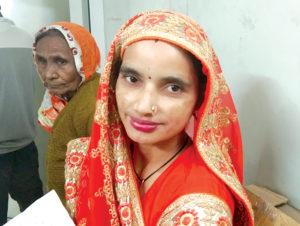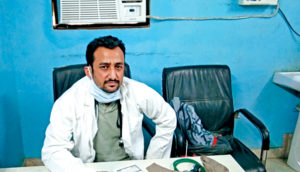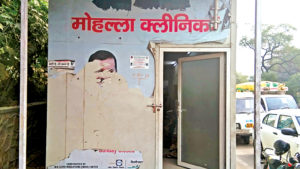AAP says Delhi’s healthcare scheme is better than Ayushman Bharat. But the Centre claims Delhi’s programme doesn’t cover ‘catastrophic expenditure’ of the poor on secondary and tertiary healthcare
On the afternoon of November 15, 2018, Emmanuel James, a resident of Delhi, received a phone call from his wife. She told him their daughter, Anna, had been hit by a car on her way back from school to their home in Mangolpuri. Badly injured, Anna had been taken to the emergency department of Maharaja Agrasen, a private hospital in Punjabi Bagh, where doctors said there was barely a two per cent chance of recovery.
James knew the expenses would be exorbitant; he expected a bill of Rs 3-4 lakh and he only earned Rs 13,000 a month. That’s when he found out about the Delhi Arogya Kosh scheme. Anna’s treatment would be free — and she subsequently made a full recovery.
Delhi Arogya Kosh is one of a host of health initiatives offered by the Aam Aadmi Party government in Delhi under its universal health coverage scheme. In June, AAP rejected the idea of implementing the Centre’s flagship health insurance scheme, Ayushman Bharat Pradhan Mantri Jan Arogya Yojana. From the Farishtey Dilli Ke scheme for accident victims like Anna to mohalla clinics, AAP’s contention is that their health schemes are “10 times better” than Ayushman Bharat.

But is AAP’s healthcare programme as good as it claims? Newslaundry decided to find out.
AAP’s universal healthcare programme in Delhi broadly has three tiers: mohalla clinics, polyclinics and tertiary care.
Mohalla clinics are primary health centres. When AAP formed the government in 2015, it ambitiously promised 1,000 mohalla clinics in the national capital. Delhi has 272 wards and, according to Shaleen Mitra, private secretary to Delhi Health Minister Satyendar Jain, the target is at least three clinics per ward.
Only about 300 mohalla clinics have been established so far — the programme has been bogged down by bureaucratic wrangling over land acquisition — but they are already a major part of Delhi’s healthcare landscape.
The clinics are shanty structures staffed by a doctor, a nurse, a pharmacist and a multitasker. The spaces are small and cramped, overflowing with boxes of medicines. Each clinic sees about 140 patients a day on average, and all patients receive free medical treatment. About 212 tests are done in the clinics, including ultrasounds and tests for thyroid and vitamin deficiency.
The average expenditure for the clinic per patient is Rs 120, says Mitra, while the doctors are paid Rs 40 per patient. Staff members work six-hour shifts, starting 8 am.

Navita Devi, a homemaker from Lado Sarai in South Delhi’s Malviya Nagar, waits patiently outside a mohalla clinic in her neighbourhood. She clutches a piece of paper with her prescription and her Aadhaar card. Navita has suffered a cold and cough for the last three days, so she’s here to get treatment.
“It’s been two years since this clinic opened and all my family members come here,” she says. “All we have to do is bring our Aadhaar cards, otherwise the pharmacist will scream at us.”
Navita’s husband works as a labourer in the industrial sector, earning a daily wage of Rs 300-400. For her, the mohalla clinic is a blessing. “The doctor is good, he sets aside a lot of time for each patient, asking us all the details of our illness,” she explains. “The medicines are also available all the time.”
Doctors assigned to mohalla clinics say most of their patients fall into the same bracket as Navika, where medical expenses are a huge strain on their budgets. Dr MK Pal, who retired from a government hospital and started working at a mohalla clinic, says the clinics function “more smoothly” than government hospitals.
“We report to a Central District Medical Officer,” Pal says. “The medicines are kept up to date. Every patient must be attended to. The more patients we see, the better it is for us, since we are paid according to the number of patients. Today, for example, 156 patients came to my clinic. Imagine if all 156 had to go to a government hospital, which is already dealing with a lot of patients.”

Mohalla clinics are generally located near residential colonies or areas with high populations. A classic example of this is a clinic at Sanjay Colony in Chattarpur’s Bhatti Mines area, South Delhi. The area has dirt roads dotted with small houses with aluminium roofs. The mohalla clinic here is one room with blue walls. The patients are mostly women and children.
Kiran Sharma, who recently moved to Sanjay Colony, is waiting for the doctor to see her pregnancy test results. She gave her blood sample on a Sunday and got her results the following day. Dr Manish Kumar is in attendance, calmly listening to patients who struggle to clearly express their health woes.
“One of the issues in areas like this is that people relied on quacks,” Kumar says. “So many patients who came to me first went to these babas and other people who prescribe medicines without proper permissions.” Posters plastered on huts in the colony are testament to this — they claim any disease can be cured in seven days.
“People usually come here with skin diseases, coughs and cold, fever, fungal infections, hypertensions,” Kumar explains. “Emergency cases are immediately transferred to the Pandit Madan Mohan Malviya hospital.”
This is where polyclinics and tertiary medical care step in. Polyclinics form the second level of healthcare, where patients meet specialised doctors and get advanced medical tests done. At least 25 polyclinics operate under the Delhi Arogya Kosh scheme.
AAP has specialised programmes under the Arogya Kosh, like Farishtey Dilli Ke, or Angels of Delhi, which encourages citizens to help accident victims. Citizens who take accident victims to hospital receive a reward of Rs 2,000, a certificate and, importantly, are protected from facing legal or punitive liabilities. The government also bears all treatment expenses of the victims of accidents, acid attacks and burn injuries.
Farishtey Dilli Ke is what helped Krishan Kumar, a barber from Nazafargarh. On the night of August 19, Kumar closed his shop and was going home. “A car hit me,” he says, “and that is all I remember. When I woke up, I was in Vikas Private Hospital in Uttam Nagar, which is where I live.”
Kumar earns Rs 200-300 a day. “The only thing I could say when I woke up was I wouldn’t be able to afford this hospital,” he says. “A friend of mine, who works for AAP, told me about a scheme that will specifically take care of accident patients.”
Krishan, like James, says he’s very grateful. However, he says once treatment is done, private hospitals are reluctant to do regular check-ups. When his leg hurt after he was discharged, the hospital told him to just “take medicines”; he did not require further treatment.
Asked about this, the private secretary to the Delhi health minister, says, “Only the initial treatment will be free, and only if the patient is taken to the hospital within 72 hours of the accident. We can’t make regular check-ups free. For that, the patient can visit government hospitals.”
So far, Rs 7,000 crore has been spent on Delhi’s universal coverage scheme, says the health minister. Jain reels off the numbers: 1,018 operations, 2.5 lakh MRI scans, 15,000 new beds, 36 tertiary hospitals functioning, and the “number of outpatients” has increased from three crore to six crore.
“In a hospital like the All India Institute of Medical Sciences, an MRI might cost Rs 3,000 instead of Rs 6,000 [as it would be in a private hospital], but you’ll have to wait for a month at least,” he says. “Under our scheme, you can get the MRI done for free and you will not have to wait.”
Jain says the scheme’s inclusivity is what makes it significant. “Ayushman Bharat serves just 5-10 per cent of the population. The middle class is a major chunk of the population and can’t be ignored.”
He dismisses claims by political rivals that AAP is giving “freebies” to voters. “We don’t care what they say. Education and healthcare should be free and of the best quality. We will ensure that.”
What about Ayushman Bharat?
For starters, neither James’s daughter nor Krishan Kumar would have been eligible for free treatment under Ayushman Bharat. Eligible families are identified based on a set of parameters. For example, it doesn’t include families that own an air conditioner, a refrigerator or private vehicle. Only members of 11 occupational categories are eligible to benefit from the scheme, including ragpickers, domestic and construction workers, and sweepers. James works as a parking attendant at a hotel and Krishan runs a barbershop in a rented space. Neither of their jobs fall under the listed categories.
The Centre’s flagship healthcare scheme aims to provide an insurance cover of up to Rs 5 lakh per family per year for secondary and tertiary care hospitalisation. It is estimated to cover over 10.74 crore families, about 50 crore beneficiaries in all. Implemented in 33 states and Union Territories, it claims to provide cashless and paperless access to health services for recipients at the point of service.
Ayushman Bharat is implemented by the National Health Authority. The authority’s chief executive officer, Dr Indu Bhushan, says Delhi’s universal coverage scheme doesn’t take care of “the catastrophic expenditure of the poor, who do not have the resources to seek secondary and tertiary care for serious illnesses”.
While Bhushan doesn’t deny the efficacy of AAP’s healthcare programme, he says it will become “considerably better” if it joins Ayushman Bharat. “It will be beneficial for the people of Delhi who are not able to afford curative or inpatient care for treatment of serious illnesses such as cancer, cardiovascular diseases, diabetes, etc,” he argues. “Ayushman Bharat is the only such scheme under which benefits are portable to all eligible beneficiaries who can avail treatment at any of the empanelled hospitals in any of the 33 States and UTs implementing Ayushman Bharat.”
He claims the Delhi government will also get Ayushman Bharat’s “state-of-the-art IT system” which he says is comparable with the “best in the world”.
According to the Ayushman Bharat annual report for 2017-18, around 46.5 lakh hospital treatments have been given so far — 24.7 lakh patients were treated by private hospitals in the past year and the remaining by public hospitals. Bhushan says, “More than 64 lakh treatments worth over Rs 9,400 crore have been carried out or are getting carried out across more than 20,900 empanelled hospitals under the scheme. Half of these hospitals are private.”
AAP has criticised Ayushman Bharat for involving insurance companies. “If the state directly provides health facilities, why involve insurance companies?” asks Satyendra Jain. “It leads to further corporatisation.”
Bhushan disagrees: “We have given flexibility to states to choose their modes — trust, insurance or mixed…In India, most health services are provided by the private sector and not government hospitals, access to which is limited for the poor. Our scheme helps open doors to both public and private hospitals for the poor.”
On September 30, the Indian Medical Association held a press conference to highlight “loopholes” in the Ayushman Bharat scheme. The association’s president, Shantanu Sen, said, “Government should take suggestions from real practising doctors, then only they can have the actual idea before fixing up these rates.” He said eligibility criteria should be based on the income of the beneficiaries.
Sen also emphasised that there should be no insurance model in place.
Delhi isn’t the only state to skip Ayushman Bharat; Odisha and Kerala have done so too. Mitra says, “Maharashtra had an excellent healthcare system before. After they introduced Ayushman Bharat, you can see how barely accessible and how chaotic the process has become.”
Bhushan says this isn’t a fair assessment. “It would not be fair to flatly say which states fair better given their individual, contextual histories of health policies, health infrastructure and socio-economic realities. The states that had health schemes running already will naturally be better at scheme implementation. However, the ‘green field’ states — those with no previous experience of running similar healthcare schemes — are picking up and will need time and assistance in showing desired results.”
Ayushman Bharat came in for more flak when its 2017-18 annual report revealed that 341 hospitals across 16 states were manipulating the scheme for their benefit. In response, the central government “delisted” 111 hospitals and also “named and shamed” them to “send a message”. The National Health Authority says it has instituted multilayered systems to curb fraud, including a National Anti-Fraud Unit and equivalent state units.
www.newslaundry.com





